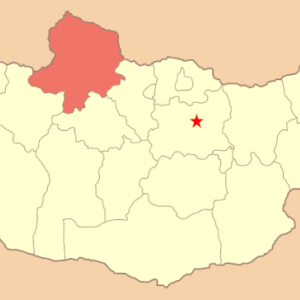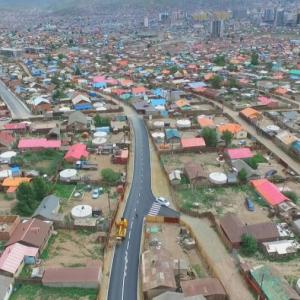Mongolia enters 2017 with 70 percent snow cover
The Mongol MessengerNumber of soums in dzud condition increases
With average sea-level elevation of 1,580 metres, Mongolia’s vast territory stretching over 1,564,116 square kilometres area comprises of diverse geographical features such as grasslands, deserts, mountain ranges covered with coniferous forests, permanent mountain glaciers and snow-topped mountains.
Mongolia is a country of harsh climate, we say. Throughout four seasons of the year, Mongolians, especially nomadic and semi-nomadic herders experience challenging weather conditions such as drought, dzud (Mongolian term for extreme winter), flooding rivers and extreme temperatures.
As a proof to the claim of extreme temperature, I bring to your notice a quick fact. Archived in World Meteorological Organization’s Global Weather & Climate Extremes is a pressure value 1089.1 hPa observed in Tosontsengel, Mongolia on December 30, 2004 in the category of Highest Sea Level Air Pressure above 750 metres. Thus, the world record of highest sea level air pressure above 750 metres is hold by Mongolia. Elevated above 1724.6 metres from sea level, the Tosontsengel site has been observed since 1963.

Unofficially dubbed as the coldest capital city in the world, weather conditions in Ulaanbaatar can also be deemed harsh, even though the consequences and damages of which aren’t as heavy as it is to herders. As recorded by Mongolian Information and Research Institute of Meteorology, Hydrology and Environment since 1961, the capital city has seen its highest temperature at plus 39.5 degrees Celsius in 2005 at Buyant-Ukhaa observation point. The minimum temperature recorded at the same observation point is minus 46.7 degrees Celsius in 2001. The maximum annual precipitation recorded in the capital city is 388 millimetres in 1967 whereas in 2015, it was 207.2 millimetres.
The Government Resolution No. 286 concerning the procedure for transmitting forecast on extreme and dangerous weather conditions states that dzud is an extreme weather condition in which livestock loss is heavy due to lack of water and pasture. Based on its intensity, dzud is classified as either dzud or dzud-like with the latter indicating a milder situation. In connection with the latest weather observed across the nation, and forecast of a possible serious dzud, the Mongol Messenger sought answers from the corresponding institution.
Dzud repetition increases
“Climate change is increasing the intensity of extreme weather conditions in Mongolia. Just like the rest of the world, climate of Mongolia is getting warmer and warmer”, Gomboluudev Purevjav, Head of Division of Climate Change Research at the Information and Research Institute of Meteorology, Hydrology and Environment.
“In some winters, certain parts of the country are affected by extreme weather conditions, and some aren’t. Because either one part of the country or locality suffers from dzud or drought, it’s hard to say that a certain year was dzud-free for the nation”, he clarified.
If we look at the past record of extreme weather on the national level, the heaviest dzuds were observed in Mongolia in 1942-1943 and 1967-1968. Then, Mongolia saw drought and dzud in consecutive years 1999-2000, 2000-2001 and 2001-2002. Then again, the winter of 2009-2010 brought another heavy dzud. What we can figure from this is that frequency of such extreme weather conditions is increasing in comparison with the multi-year average for Mongolia”.
Over 1 million livestock lost last year

After the heavy loss of 2010, the 2015-2016 winter wasn’t exactly sympathetic towards Mongolian herders whose livings depend on the temperament of nature. Following a drought in the summer of 2015, the winter brought 2016 with another dzud which resulted in the loss of 1 million and 70 thousand heads of livestock.
According to a 2015-2016 report of Division of Agrometeorology of the Information and Research Institute of Meteorology, Hydrology and Environment, 58 soums of 17 provinces were in dzud and 56 soums of 14 provinces were in dzud-like situation. (Provinces are divided into soums)
Moreover, the report shows that snow fell heavily around mid November of 2015 to cover 80 percent of the whole territory, and advanced to 90 percent of the territory by the end of November. And the snow remained to cover the territory until late February. As of February 29, the report reads, about 70 percent of the territory was covered in snow, the thickness of which varied in different parts of the country.
Snow cover is deeper than last year
The Information and Research Institute of Meteorology, Hydrology and Environment issued a dzud risk report in late November this year, forecasting a possible difficult wintering in 50 percent of the country. The report showed that the risk is especially higher in provinces like Bayan-Ulgii, Uvs, Tuv, Darkhan-Uul, Khentii, Sukhbaatar and Dornod.
As of November 20 this winter, about 70 percent of the country was covered in snow, and the deepest snow cover recorded in grasslands was 30-40 cm with 50-60 cm deep snowdrift. The report had indicated that 45 Soums of 13 provinces were in dzud and 39 Soums of 13 provinces were in dzud-like situation.
On January 3, the Institute of Meteorology, Hydrology and Environment released a report on wintering situation over the last 10 days of December, 2016. The snow cover remains the same amount as the November report with increase in number of Soums at risk. The latest report reveals that as of December 31, 65 Soums of 15 provinces are in dzud and 66 Soums of 14 provinces are in dzud-like condition.
During the last 10 days of December, air temperature exceeded minus 30 degrees Celsius for 9-11 days and soil temperature surpassed minus 40 degrees Celsius for 3-8 days in certain soums of Zavkhan, Bayankhongor, Khuvsgul and Selenge provinces. The lowest temperature recorded during the time span is minus 47 degrees Celsius. The depth of snow cover is 21-50 cm at its deepest with high density.
“So far, we’ve measured lesser area of snow cover than last year. But in certain places, especially in the northern parts of Mongolia, the snow cover is extremely deep. Domestic animals can’t dig through 30 cm deep snow which is high in density to graze. Herders reported that they began feeding their reserved forage and hay to the herd as soon as in November”, said Erdenetsetseg Baasandai, Head of Department of Agrometeorology at the Information and Research Institute of Meteorology, Hydrology and Environment to the Mongol Messenger.
Furthermore, she shared to the Mongol Messenger an abstract report on the dzud of 2009-2010, the most recent major dzud that heavily damaged Mongolia’s livestock sector. “In 2009 summer, 20 percent of total territory had severe drought, 40 percent had semi-drought conditions and remaining 40 percent had normal pasture condition, and pasture carrying capacity estimation showed 55 percent of total territory was expected to have unfavorable winter condition. In the fall of 2009, snow fell early in most of the territory and snow cover started forming by the end of October. The snow cover was 5-30cm in more than 70 percent of the total territory in the end of November.
More than 90 percent of the territory had snow by the end of January 2010 while 40 percent of the territory with snow had snow depth of 30-48cm. As of March 31, 2010, the snow kept forming in more than 80 percent of the territory, which led to formation of ice layer in some places. Due to deep snow that formed for six months in the most of the territory, conditions for white dzud were formed and there was a great loss of livestock. Another major factor that led to the dzud was the exceptionally cold weather. In January, 2010, the air temperature was 3.0-6.30C colder than the multi-year average, which formed the conditions for a cold dzud”.
In the 2009-2010 dzud, Mongolia’s livestock industry suffered a 20 percent decrease with loss of about 8-9 million heads of livestock. The situation affected 769 thousand people who constituted 28 percent of the population.
This year, Mongolian herders have braced themselves for one of the coldest and snowiest winters considering the dzud risk report of the Information and Research Institute of Meteorology, Hydrology and Environment, and given the general belief that Lunar Year of the Monkey has been known to bring the heaviest of dzuds. Among the herder folks of Mongolia who look after over 60 million heads of livestock, the Lunar Year of the Monkey is notorious for it.
We don’t know for certain whether if the current dzud is about to escalate into a serious situation as in the above-illustrated report by Erdenetsetseg; yet we can only expect the worst and hope for the best.
Kh.Aminaa
Photo by B.Chadraabal
The article was featured in Mongol Messenger's issue No.1 for January 6, 2017.
 Ulaanbaatar
Ulaanbaatar













































































